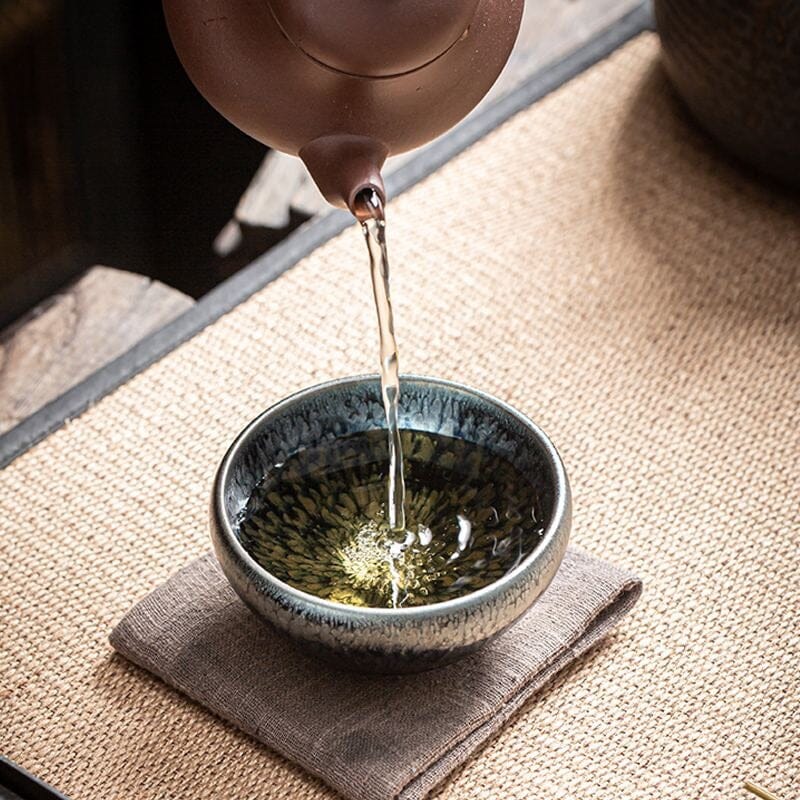"High mountain clouds and mist produce good tea" is an age-old saying in Chinese tea culture, and it is also a scientifically verified conclusion. From West Lake Longjing to Wuyi Rock Tea, from Huangshan Maofeng to Yunnan Pu'er, many renowned tea varieties originate from high-altitude mountainous areas. The high mountain cloud and mist environment acts like a skilled craftsman, endowing tea with a fresh taste, rich aroma, and abundant nutrients through unique climate, soil, and ecological conditions. This article will comprehensively analyze the scientific principles behind the cultivation of high-quality tea in high mountain clouds and mist from four dimensions: geographical environment, climatic characteristics, soil conditions, and ecosystem, uncovering the mystery of the excellent quality of alpine tea.
1. High-Altitude Climate: A Natural Regulator Shaping Tea Flavor
The climatic conditions in high-altitude mountainous areas differ significantly from those in plain areas. These differences directly affect the growth rhythm and internal substance accumulation of tea trees through factors such as temperature, light, and humidity, forming the core of alpine tea quality.
(1) Day-Night Temperature Difference: Stimulating Nutrient Accumulation
High-altitude mountainous areas generally have the climatic characteristic of "large day-night temperature difference". During the day, solar radiation is strong, and tea trees have vigorous photosynthesis, synthesizing large amounts of nutrients such as carbohydrates and amino acids; at night, temperatures drop sharply, weakening the respiratory effect of tea trees and reducing energy consumption, allowing the nutrients synthesized during the day to accumulate fully. This "high accumulation, low consumption" metabolic pattern makes the amino acid content of alpine tea 20%-30% higher than that of plain tea. Amino acids are the main source of the fresh taste of tea and the key to forming the "fresh and sweet aftertaste" characteristic of alpine tea.
(2) Diffused Light: Balancing Photosynthetic Efficiency and Aroma Substance Synthesis
High mountain areas have frequent cloud and mist weather, with cloud layers acting as natural "soft light covers", converting direct light into diffused light. For tea trees, the wavelength of diffused light is more suitable for chlorophyll absorption, improving photosynthetic efficiency; at the same time, diffused light can reduce damage to tea leaves from strong light, protecting aromatic substances in the leaves from destruction. Studies have shown that alpine tea has 10-15 more types of aromatic substances than plain tea, with particularly rich contents of characteristic aroma substances such as terpenes and alcohols. This is also an important reason why alpine tea has a clear, high, and long-lasting aroma with rich layers.
(3) Humidity and Precipitation: Ensuring Tea Freshness and Tenderness Retention
High mountain areas are covered with clouds and mist, and the relative air humidity usually remains at 70%-80%. This high humidity environment can reduce the transpiration of tea tree leaves, preventing tea leaves from becoming coarse and old due to water shortage. At the same time, high mountain areas have abundant and evenly distributed precipitation, mostly unpolluted natural rainfall, which can provide continuous and stable water supply for tea trees, keeping the tea leaves fresh and tender with strong tenderness retention. After picking, alpine tea leaves are flexible and elastic, not easily broken during processing, and can better retain complete nutrients and aroma components.
2. Soil Conditions: A Natural Nutrient Bank Nourishing Tea Trees
The soil in high-altitude mountainous areas has formed a unique soil environment suitable for tea tree growth through long-term geological movements and vegetation cycles, providing rich minerals and trace elements for tea, which is the material basis of alpine tea quality.
(1) Soil Acidity-Alkalinity and Permeability: Optimizing Root Absorption Efficiency
Alpine tea gardens are mostly distributed on slopes or mountains, with yellow soil and red soil as the main soil types, usually with a pH value between 4.5-6.0, showing weak acidity, which is exactly suitable for the growth of tea tree roots. At the same time, alpine soil has high weathering degree, rich organic matter, loose soil structure, large porosity, good air permeability and drainage, which can ensure that tea tree roots obtain sufficient oxygen and water, promoting the absorption of minerals by the roots. Healthy roots are the basis for vigorous growth of tea trees and the premise for rich nutrients in tea.
(2) Minerals and Organic Matter: Endowing Tea with Unique Flavor Background
Alpine soil is rich in minerals and trace elements such as potassium, calcium, magnesium, iron, and zinc. These elements are absorbed by tea tree roots into the leaves, participating in the synthesis of internal substances in tea and affecting the taste and color of tea. For example, potassium can enhance the freshness of tea, zinc is closely related to amino acid synthesis; and the decayed leaves of dense vegetation in high mountain areas form rich organic matter, making the soil fertile and naturally pollution-free, providing balanced nutrition for tea tree growth, avoiding common problems of soil compaction and single nutrients in plain areas.
(3) Altitude and Soil Age: Affecting the Depth of Material Accumulation
With the increase of altitude, the formation time of soil is relatively short, the weathering degree is moderate, and minerals are not excessively leached, providing more comprehensive nutrition for tea trees; at the same time, high-altitude areas have less human activities, and the probability of soil being polluted by chemical fertilizers and pesticides is extremely low, maintaining a natural and pure state. This "young and pure" soil characteristic makes the heavy metal content of alpine tea much lower than that of plain tea, with safer quality and more natural flavor.

3. Ecological Environment: A Natural Protective Barrier for Tea Tree Growth
The unique ecosystem in high-altitude mountainous areas creates a pollution-free environment with rich biodiversity for tea tree growth, reducing the occurrence of diseases and pests through ecological balance mechanisms and improving the purity of tea quality.
(1) Biodiversity: Building a Natural Ecological Defense Line
High mountain areas have dense vegetation, with forests, bamboo forests, and tea gardens distributed alternately, forming a complex ecosystem. This ecosystem contains a large number of beneficial insects, birds, microorganisms, and other biological populations, which form a natural pest control network, reducing the occurrence probability of tea tree diseases and pests. Compared with plain tea gardens, alpine tea gardens rarely need to use pesticides, and the pesticide residue in tea is extremely low, truly realizing "ecological planting", which is also an important guarantee for the pure quality of alpine tea.
(2) Less Environmental Pollution: Ensuring the Natural Taste of Tea
High-altitude mountainous areas are far from pollution sources such as cities and industrial zones, with air, water sources, and soil all maintaining good natural conditions. Research shows that the air quality in high mountain areas reaches the national first-class standard, the pH value of precipitation is close to neutral, and there is no pollution from industrial wastewater and waste gas. Tea trees growing in this pure environment have clean leaves without pollutant accumulation, and the produced tea can retain the natural taste to the greatest extent, avoiding the possible peculiar smell or pollution risk of plain tea.
(3) Long Growth Cycle: Accumulating More Rich Flavor Substances
Due to the lower temperature in high-altitude areas, tea trees grow slower, with a growing period one to two months shorter than that of plain tea trees in a year. However, it is this "slow growth" characteristic that allows tea trees to have more sufficient time to accumulate nutrients and flavor components. Alpine tea leaves have thinner cell walls, high cell sap concentration, and richer internal substances. After brewing, the taste is more intense and the brewing endurance is higher, usually maintaining good flavor for 2-3 more infusions than plain tea.
4. Human Factors: The Perfect Combination of Traditional Craftsmanship and Natural Endowment
The excellent quality of alpine tea not only comes from the gifts of natural conditions but also is inseparable from the traditional planting and production techniques of local tea farmers. Human factors further amplify the advantages of high mountain clouds and mist through scientific utilization of natural conditions.
(1) Refined Planting: Farming Wisdom Following Natural Laws
Alpine tea farmers follow the planting concept of "complying with nature" and adopt traditional farming methods such as manual weeding, applying organic fertilizers, and reasonable pruning, avoiding excessive intervention in tea tree growth. According to the climatic characteristics of high mountains, they select suitable tea tree varieties, such as local group varieties with strong cold resistance and excellent quality, and make full use of mountain light and land resources through reasonable dense planting and terraced planting, allowing tea trees to grow healthily under natural conditions.
(2) Timely Harvesting: Capturing the Best Quality Window Period
The harvesting time of alpine tea strictly follows the growth law of tea, mostly choosing to harvest around the Qingming Festival to Grain Rain period, when the temperature is moderate and the proportion of internal substances in tea is optimal. The harvesting standard is mostly "one bud and one leaf" or "one bud and two leaves" to ensure that the picked fresh leaves have moderate tenderness and uniform quality. At the same time, alpine tea farmers insist on manual picking to avoid damage to tea caused by mechanical picking, ensuring the integrity of fresh leaves and laying a good foundation for subsequent processing.
(3) Traditional Craftsmanship: Production Techniques Highlighting Natural Flavor
The production process of alpine tea focuses on "moderate processing", retaining the natural flavor of tea to the greatest extent through processes such as fixing, rolling, and drying. For example, alpine green tea mostly uses low-temperature fixing to avoid high temperature damaging fresh substances; oolong tea, taking advantage of the high aroma substance content of alpine tea, stimulates floral and fruity aromas and rock rhyme through precise leaf conditioning and roasting processes. The combination of traditional craftsmanship and natural endowment fully demonstrates the quality advantages of alpine tea.

5. Common Misunderstandings Analysis: Correct Understanding of Alpine Tea Quality
(1) Misunderstanding 1: The Higher the Altitude, the Better the Tea Quality
Although high altitude improves tea quality, it does not mean that the higher the altitude, the better. Generally speaking, the most suitable altitude range for tea tree growth is 800-1500 meters. Beyond 1800 meters, low temperatures may cause tea tree growth to stagnate and insufficient accumulation of internal substances in tea leaves. In addition, altitude is only one of the influencing factors, and comprehensive judgment should be made in combination with soil, climate, variety, etc.
(2) Misunderstanding 2: All Alpine Teas Have the Same Quality
The quality of alpine tea is affected by factors such as microclimate, soil type, and planting technology in specific producing areas. Even in the same high-altitude area, the tea quality of different tea gardens varies. For example, the light and humidity of south-facing and north-facing slopes are different, so the tea flavor will be different; tea trees grown in volcanic rock soil and red soil will also have different mineral contents.
(3) Misunderstanding 3: Alpine Tea Does Not Need to Pay Attention to Craftsmanship
Natural conditions are the basis of alpine tea quality, but craftsmanship is also crucial. If the fixing is excessive, rolling is improper, or drying is not timely during processing, even high-quality alpine fresh leaves will produce low-quality tea. Only the combination of natural endowment and exquisite craftsmanship can achieve truly high-quality alpine tea.
Behind the saying "high mountain clouds and mist produce good tea" lies the joint action of multiple factors such as climate, soil, ecology, and humanity. The day-night temperature difference, diffused light, and pure water sources at high altitudes provide an ideal growth environment for tea trees; fertile and pollution-free soil nourishes the rich internal substances of tea; the ecosystem with biodiversity ensures the natural purity of tea; and traditional craftsmanship transforms these natural advantages into unique flavors. Understanding the formation principle of alpine tea quality not only allows us to better appreciate the flavor of tea but also realize the wisdom of harmonious coexistence between humans and nature - the birth of good tea has always been the perfect integration of natural gifts and human ingenuity.











Condividere:
How to Brew Bamboo Nest Narcissus
Spring Tea is on The Market, How to Choose Green Tea?